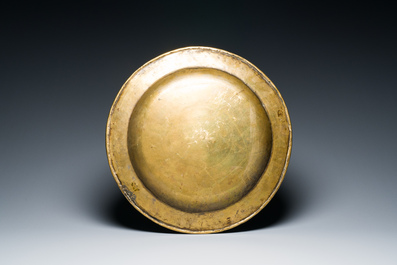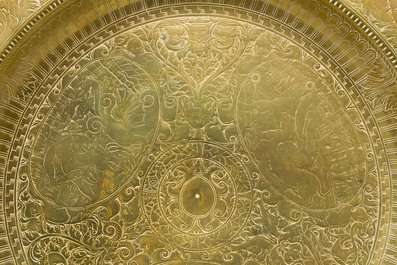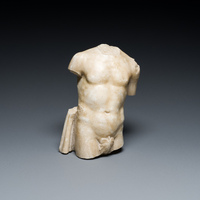We have to double-check your registration and make sure this is not an automated entry in our system. Please complete the test below...
An Italian finely engraved brass dish with mythological scenes and grotesques, Venice, 16th C.
Dia.: 46 cm - H.: 5,5 cm
Ref.: The Victoria and Albert Museum, London, Accession number M.38-1946, for another example. (link) The catalogue entry states:
In Venice, the production of brass dishes flourished in the first half of the 16th century. They were very elaborately decorated but not with traditional European linear ornamentation. Venice, during this period, traded and fought extensively with the Turkish and Arab empires which bordered the Mediterranean basin. Thus Venetian merchants brought back to the city Near Eastern craftsmen and goods that had an immediate influence on the indigenous population, and eventually the rest of Europe.
The Venetian Muslim community produced many splendid damascened brass vessels, some of which are signed in Arabic by their makers. The decoration was more extensive, often covering the entire surface of an object. The arabesque pattern, base on a stylised plant with a winding stem, was studied and copied by contemporary Italian artists. By the middle of the 16th century, the arabesque as a form of ornament was beginning to influence craftsmen all over Europe, and became incorporated into the development of European ornamental design, until the decline of the Rococo in the late 18th century.
The local craftsmen adopted the deep, bold engraving characterising their Islamic prototypes but only very occasionally used the silver inlay which was a speciality of the Saracen artists. Other subject matter incorporated into the decoration of these dishes by local, as opposed to Saracenic craftsmen, was characteristic of the late Renaissance: flowers, busts, erotic scenes, grotesques, sirens, birds, battle scenes, hunting scenes, triumphal processions and incidents taken from mythology. There is often a coat of arms in the centre which implies that many of the clients were members of the aristocracy.






